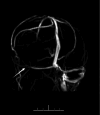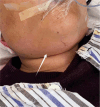Intraoperative Finding of Potential Ludwig's Angina Resulting from the Spread of Middle Ear Cholesteatoma Following Head Trauma: A Case Report
- PMID: 40767556
- PMCID: PMC12334994
- DOI: 10.5152/iao.2025.241804
Intraoperative Finding of Potential Ludwig's Angina Resulting from the Spread of Middle Ear Cholesteatoma Following Head Trauma: A Case Report
Abstract
Ludwig's angina is a cellulitis involving multiple spaces in the floor of the mouth. It is mainly associated with odontogenic infections and head or facial trauma, which may result in death by asphyxiation due to sudden airway obstruction. By presenting a case of Ludwig's pharyngitis second- ary to middle ear cholesteatoma, it was aimed to alert otolaryngologists to the potential risks and management of this disorder. The patient was a 49-year-old woman with a 40-year history of middle ear cholesteatoma. Ten days prior to her admission, she sustained an ipsilateral punch injury to the tempo-lateral region, which was followed by postauricular erythematous swelling, pain, and postauricular subperiosteal abscess forma- tion. Sudden mandibular swelling was found during postoperative extubation from middle ear cholesteatoma surgery. In order to prevent the occurrence of sudden acute asphyxia in the postoperative period, an immediate prophylactic tracheotomy was carried out to establish an artifi- cial airway. The patient was subsequently treated with antibiotics and had an uneventful recovery. Prompt diagnosis and aggressive therapeutic interventions are essential for successfully managing Ludwig's angina.
Figures






Similar articles
-
Ludwig's Angina and a Complicated Course of Streptococcus constellatus Management.J Intensive Care Med. 2025 Jul 8:8850666251357488. doi: 10.1177/08850666251357488. Online ahead of print. J Intensive Care Med. 2025. PMID: 40625197
-
Floor of the Mouth Ultrasound Assessment in Ludwig's Angina.J Emerg Med. 2025 Jul;74:86-91. doi: 10.1016/j.jemermed.2025.02.013. Epub 2025 Feb 11. J Emerg Med. 2025. PMID: 40518359
-
Fatal airway obstruction due to Ludwig's angina from severe odontogenic infection during antipsychotic medication: A case report and a literature review.J Forensic Sci. 2021 Sep;66(5):1980-1985. doi: 10.1111/1556-4029.14740. Epub 2021 Apr 27. J Forensic Sci. 2021. PMID: 33904596 Review.
-
Ludwig's angina following frenuloplasty in an adolescent.Int J Pediatr Otorhinolaryngol. 2009 Sep;73(9):1313-5. doi: 10.1016/j.ijporl.2009.05.022. Epub 2009 Jun 26. Int J Pediatr Otorhinolaryngol. 2009. PMID: 19560216
-
[Volume and health outcomes: evidence from systematic reviews and from evaluation of Italian hospital data].Epidemiol Prev. 2013 Mar-Jun;37(2-3 Suppl 2):1-100. Epidemiol Prev. 2013. PMID: 23851286 Italian.
References
-
- Mengsha W, Jun Y, Yasheng Y. Middle ear cholesteatoma with Mouret abscess--a case report. Zhonghua Er Bi Yan Hou Tou Jing Wai Ke Za Zhi. 2015;50(3):244. - PubMed
Publication types
MeSH terms
LinkOut - more resources
Full Text Sources
Medical
